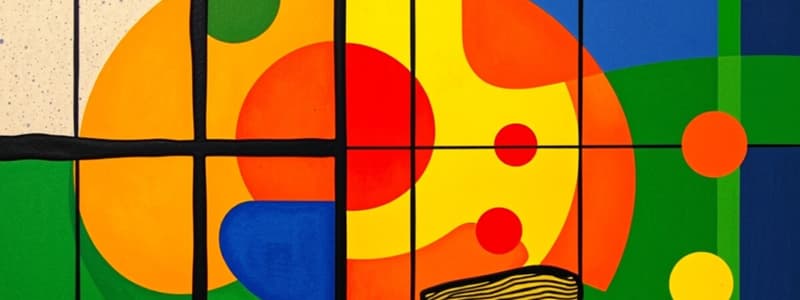Podcast
Questions and Answers
What does Oculomotor control refer to?
What does Oculomotor control refer to?
- Learning to link stimuli
- Eye movement (correct)
- Sound related processing
- Meaning related processing
What is visual processing mainly concerned with?
What is visual processing mainly concerned with?
- Sound processing
- Meaning interpretation
- Memory retention
- Color and form (correct)
Which of the following is involved in phonological processing?
Which of the following is involved in phonological processing?
- Letters (correct)
- Sound related processing
- General knowledge
- None of the above
What does morphological and semantic processing relate to?
What does morphological and semantic processing relate to?
What is the significance of Donders' work in psychology?
What is the significance of Donders' work in psychology?
What does the reaction time (RT) experiment measure?
What does the reaction time (RT) experiment measure?
What is a cognitive map?
What is a cognitive map?
Behaviorism focuses on internal mental processes.
Behaviorism focuses on internal mental processes.
Match the following psychologists with their contributions:
Match the following psychologists with their contributions:
Who is known for the phrase 'the magical number 7, plus or minus 2'?
Who is known for the phrase 'the magical number 7, plus or minus 2'?
What is the number of neurons in the human body?
What is the number of neurons in the human body?
What does EEG provide information about?
What does EEG provide information about?
Flashcards
Visual Processing
Visual Processing
The ability to interpret visual information, including color and form, drawing upon perception, attention, and memory.
Orthographic Processing
Orthographic Processing
The recognition of letters, based on visual representation, heavily relying on attention and memory.
Phonological Processing
Phonological Processing
The understanding of sound, connecting to attention and memory, crucial for language comprehension.
Morphological and Semantic Processing
Morphological and Semantic Processing
Signup and view all the flashcards
Syntactic Processing
Syntactic Processing
Signup and view all the flashcards
Pragmatic Processing
Pragmatic Processing
Signup and view all the flashcards
Reaction Time (RT) Experiment
Reaction Time (RT) Experiment
Signup and view all the flashcards
Savings Curve
Savings Curve
Signup and view all the flashcards
Behaviorism
Behaviorism
Signup and view all the flashcards
Cognitive Revolution
Cognitive Revolution
Signup and view all the flashcards
Selective Attention
Selective Attention
Signup and view all the flashcards
Atkinson and Shiffrin's Three-Stage Model of Memory
Atkinson and Shiffrin's Three-Stage Model of Memory
Signup and view all the flashcards
Study Notes
Oculomotor Control and Visual Processing
- Oculomotor control refers to eye movements, involving perception, attention, and memory.
- Visual processing encompasses the interpretation of color and form, also engaging perception, attention, and memory.
Orthographic and Phonological Processing
- Orthographic processing involves recognizing letters, related to attention and memory.
- Phonological processing is concerned with sound, connecting to attention and memory as well.
Morphological, Semantic, and Syntactic Processing
- Morphological and semantic processing focus on meaning, linking with attention and memory.
- Syntactic processing relates to the structure of language, requiring attention and memory for comprehension.
Pragmatic Processing and Cognitive Functions
- Pragmatic processing addresses the context of communication, like probing the reason behind a professor's question.
- Broad cognitive processes include perception, attention, memory, language, and complex tasks such as problem solving and decision-making.
Understanding the Mind and Cognition
- The mind encompasses systems for processing mental functions including perception, memory, emotions, and reasoning.
- Cognition refers to the mental processes that characterize how the mind creates reality, consisting of perception, attention, and memory.
Key Figures and Historical Perspectives
- Donders (1868) pioneered the measurement of decision-making time, emphasizing reaction times as a key cognitive metric.
- The Reaction Time (RT) Experiment assesses the time from stimulus presentation to response.
- Ebbinghaus (1885/1913) studied memory retention and forgetting through nonsense syllables, establishing the savings curve concept.
Behaviorism and Conditioning
- John Watson promoted behaviorism, focusing on observable behavior and reactions, exemplified by the Little Albert study.
- Classical conditioning involves linking stimuli to predict events, while operant conditioning connects behaviors with their consequences.
Learning Theories
- Tolman introduced concepts of latent learning and cognitive mapping, demonstrating that learning occurs without immediate display.
- Skinner linked verbal behavior to operant conditioning, suggesting that children learn language through imitation and reinforcement.
Paradigms and Technological Advances
- Paradigms denote the methodologies used in various psychological schools of thought, shifting with technological progress.
- The advent of digital computers initiated a major paradigm shift in understanding cognition and mind processes.
Attention and Cognitive Processing
- Cherry (1953) explored selective attention, illustrating how individuals can focus on specific messages amidst competing stimuli.
- Broadbent (1958) created the first flow diagram of mental processes, depicting how attention is directed to stimuli.
Cognitive Science Emergence
- 1956 is marked as the birth year of cognitive science, centered around a crucial MIT symposium on information theory, leading to advancements in cognitive psychology.
- Ulrich Neisser published the first cognitive psychology textbook in 1976, primarily addressing perception.
Memory Models
- Atkinson and Shiffrin proposed a three-stage model of memory: sensory memory (瞬間的), short-term memory (limited), and long-term memory (durable).
- Tulving distinguished between semantic (general knowledge) and episodic (event-specific) memory within the realm of long-term memory.
Neuroscience and Imaging Technologies
- Electrophysiology examines the electrical activities of the nervous system, while brain imaging technologies (PET, fMRI) visualize brain activity during cognitive tasks.
- EEG provides insights regarding the timing of cognitive processes, whereas fMRI offers spatial location data concerning brain activity.
Neuronal Structure and Function
- The Neuron Doctrine asserts that individual nerve cells transmit signals independently rather than being continuous.
- The human body contains approximately 86 billion neurons, forming around 160 trillion connections to facilitate communication within the nervous system.
Studying That Suits You
Use AI to generate personalized quizzes and flashcards to suit your learning preferences.




